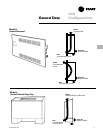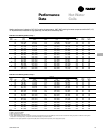
General Data
CAB-PRC001-EN
14
Electric Heat
All Force-Flo™ cabinet heaters, except
inverted models M and N, are available
with electric heating coils as a standard
option.
Coil Construction
Electric heat coils are open wire type with
a nickel chromium element design.
Power Supply
Units have single-point power since the
electric heating elements operate on line
voltage. Electric heat is available as
208/60/1, 230/60/1, 277/60/1, 208/60/3, or
480/60/3. Electric heat coils operate on the
same voltage as the unit, except for units
with 480/60/3 electric heat. In this case, the
unit operates at 277/60/1, thus requiring a
4-wire supply. All fans and motors are
single phase. In addition, all control
options are 24-volt, utilizing a factory-
installed transformer.
Power Supply Location
All electric heat cabinet heaters have a
terminal block for main power on the
unit’s right-hand side.
Control Type
Single-stage electric heat units are
controlled by any of the Tracer
®
ZN
control options. Two-stage electric heat is
controlled by the Tracer ZN.520 only. Both
control options use PWM (pulse-width
modulation) outputs to calculate the
electric heat output based on the capacity
request and the electric heat cycles per
hour. For example, if the electric heat
cycles per hour is configured for six
cycles (as Trane recommends) the
controller bases the output on or off time
on six 10-minute periods. If the capacity
request is 40%, the controller controls the
electric heat output on for approximately
four minutes each period.
Safety Features
• All Force-Flo units with standard electric
heat are UL listed.
• Units require only a single-point
electrical connection.
• All electric heating coils are interlocked
with the fan motor switch. Therefore,
electric heat operation is only possible
when the fan is running.
• Each unit has a transformer, eliminating
the need for field installation of a step-
down transformer.
• A unit mounted magnetic contactor(s) is
(are) supplied on all unit voltages.
• A high temperature cutout with auto-
matic reset de-energizes the electric
heat in the event of an overheat condi-
tion.
Electric Heat


















